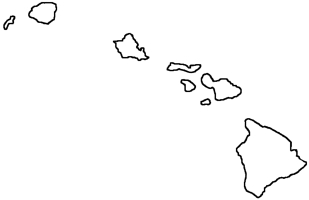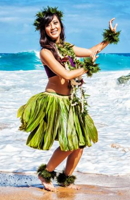
|
The Society of Folk Dance Historians (SFDH) Hawai'i
[
Home |
About |
Encyclopedia | CLICK AN IMAGE TO ENLARGE |

|
BACKGROUND
Information: A state and a culture.
Hawai'i (pronounced ha-VAI-ee) – also Hawaii (pronounced ha-WAI-ee) – is the only American state located in Oceania, the only American state located outside North America, and the only one composed entirely of islands.
The eight main islands are, in order from northwest to southeast: Niʻihau, Kauaʻi, Oʻahu, Molokaʻi, Lānaʻi, Kahoʻolawe, Maui, and the Island of Hawaiʻi. The last is the largest island in the group and is often called the "Big Island" or "Hawaiʻi Island" to avoid confusion with the state or archipelago. Hawai'i's diverse natural scenery, warm tropical climate, abundance of public beaches, oceanic surroundings, and active volcanoes make it a popular destination for tourists, surfers, biologists, and volcanologists.
Hawai'i's culture is strongly influenced by North American and East Asian cultures, in addition to its indigenous Hawai'ian culture. The aboriginal culture of Hawai'i is Polynesian. Hawai'i represents the northernmost extension of the vast Polynesian Triangle of the south and central Pacific Ocean. While traditional Hawai'ian culture remains as vestiges in modern Hawai'ian society, there are re-enactments of the ceremonies and traditions throughout the islands.
The Japanese attack on Pearl Harbor in 1941 was the primary event that caused the United States to enter World War II.
National Dance: Hula
Languages: English and Hawai'ian are listed as Hawai'i's official languages in the state's 1978 constitution, in Article XV, Section 4. However, the use of Hawai'ian is limited because the constitution specifies that "Hawai'ian shall be required for public acts and transactions only as provided by law."
Religions: Christian and Protestant.
- Ami Kāhela
- Rotation of the hips, one rotation per beat.
- Ami Kūkū
- Same as the Ami Kāhela, except that the revolutions are small, faster, and in groups of three.
- Hela
- One ft is placed at about a 45-degree angle to the front, with the wt on the opp hip and with that knee bent. The ft is then returned to the original position and the step is repeated with the other ft.
- Ka'o
- Side-to-side hip sway. Feet: Step R, touch L, and reverse.
- Kāholo
- Extend one ft to the side. Bring the other along side. (Step, together, step, touch.) Repeat with the other ft.
- Kāholo Huli
- To execute the Kāholo while turning in a circle – if initiating the Kāholo with the R ft, the turn will be toward the R.
- Kāholo Swing
- To execute the Kāholo wo the R or L with 1/4 or 1/2 turn.
- Kawelu
- Step fwd with one ft while the other is stationary, lifting the stationary ft off the heel slightly, shifting the wt (hips) accordingly. Can be done traveling.
- Lele
- Step fwd on R ft (ct 1); tap ball of L ft next to R ft (ct 2); step fwd on L (ct 3); tap ball of R ft next to L ft (ct 4). Variations: Step Tap bkwd or walk "around the island." Can also be done with no tap.
- Olapa
- With wt on L, R ft moves to the side (ct 1); R ft moves to the front (ct 2); R ft moves together next to L (ct 3); Ūwehe (ct 4). Step is then repeated using the L ft. Occasionally, the entire step is done in reverse by moving the ft to the front first, then side, together, and Ūwehe.
- Ūwehe
- One ft is lifted with wt shifting to the opp hip as the ft is lowered. Both knees are then pushed fwd by the quick raising of the heels with continued swaying of the hips from side to side.
- Ūwehe
- One ft is lifted with wt shifting to the opp hip as the ft is lowered. Both knees are then pushed fwd by the quick raising of the heels with continued swaying of the hips from side to side.
The following information on hula implements is provided for the teacher's general knowledge. As most of these implements are not readily available on the mainland, we will not go into great detail on their usage at this time. Perhaps that would be a good subject for later, more advance hula material and videotape.
- 'Ili'ili
- (EE-lee-EE-lee) Four smooth, oval stones, often of volcanic rock, that are held two in each hand. When clicked together, they sound similar to the noise made by Spanish castanets.
- 'Ulī'ulī
- (oo-LEE-oo-LEE) A small gourd or coconut partially filled with canna seeds that make a "rattle" sound when shaken. It is held by a handle and covered with a feathered, circular top, usually of red and yellow or natural brown feathers.
- Ipu
- (EE-poo) A large, hollow gourd held by the neck in the left hand and hit with the heel and fingers of the right hand to produce a resonant, drum-like sound.
- Ipu heke
- (EE-poo HEH-keh) A double Ipu is created by gluing two smaller Ipus together. It is used in ancient hula and is played by the chanter, who sits and strikes it with the hand and on the ground.
- Kāla'au
- (kah-lah-OW) Sticks made of Hi'a or Kauila wood about twelve inches long that are struck together to produce a sharp, staccato sound.
- Pahu.
- (PAH-hoo) A sharkskin-covered drum, considered sacred.
- Pū'ili
- (poo-EE-lee) Two sections of bamboo stalks that have been split into narrow strips. When struck on the body or against each other, they produce a pleasant, rustling sound.
- Puniu.
- (poo-NEE-oo) A small knee drum made of coconut shell with fish skin ("kala") cover.
- Ipu Heke
- (EE-poo HEH-keh) A double ipu is created by gluing two smaller ipus together. It is used in ancient hula na is played by the chanter, who sits and strikes it with the hand an on the ground.
- Tiger Coweries
- Shells.
DOCUMENT
- Beware of Gift Giving Customs in Foreign Lands, a list.
- Hula, a dance family.
- Polynesia, a region.
- United States, a country.
This page © 2018 by Ron Houston.
Please do not copy any part of this page without including this copyright notice.
Please do not copy small portions out of context.
Please do not copy large portions without permission from Ron Houston.

